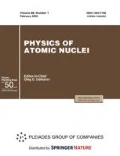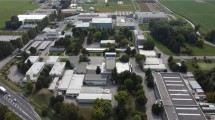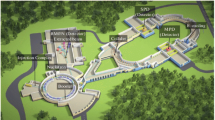Abstract
Investigation of properties of nuclear matter at extremely high temperature and/or extremely high baryon densities under laboratory conditions is one of the fundamental lines of research in high-energy physics. Throughout the past decades, such investigations have been performed in collisions of ultrarelativistic heavy ions in several experiments at modern accelerator complexes, including the Relativistic Heavy Ion Collider (RHIC) at Brookhaven National Laboratory (BNL, USA) and the Large Hadron Collider (LHC) at CERN (Switzerland). In the near future, it is also planned to launch investigations of this kind at the FAIR (Facility for Antiproton and Ion Research at Gesellschaft für Schwerionenforschung (GSI), Darmstadt, Germany) and NICA (Nuclotron-based Ion Collider fAcility at Joint Institute for Nuclear Research (JINR), Dubna, Russia) accelerators. In order to implement such investigations, it is necessary to create sophisticated detector systems that are able to record events featuring high-multiplicity product particles and to measure reliably their properties. The present article gives a brief survey of all detector systems that have already been created and are being developed at Laboratory of Relativistic Nuclear Physics at Petersburg Nuclear Physics Institute (National Research Center Kurchatov Institute) for the PHENIX (BNL, USA), ALICE (CERN, Switzerland), and CBM (GSI, Germany) experiments aimed at studying nuclear matter under extreme conditions.






Similar content being viewed by others
REFERENCES
PHENIX Collab. (K. Adcox et al.), Nucl. Phys. A 757, 184 (2005).
The ALICE Collab. (K. Aamodt et al.), J. Instrum. 3, S08002 (2008)
CBM Collab. (T. Ablyazimov et al.), Eur. Phys. J. A 53 (3), 60 (2017).
D. Blaschke, J. Aichelin, E. Bratkovskaya, V. Friese, M. Gazdzicki, Y. Randrup, O. Rogachevsky, O. Teryaev, and V. Toneev, Eur. Phys. J. A 52, 267 (2016).
C. E. Pérez Lara (for the sPHENIX Collab.), EPJ Web Conf. 171, 10002 (2018).
A. Uras (for the ALICE MFT Working Group), J. Phys.: Conf. Ser. 446, 012054 (2013).
V. Patel and M. Traxler, J. Instrum. 13, C03038 (2018).
ACKNOWLEDGMENTS
I am grateful to A.V. Khanzadeev, M.B. Zhalov, V.N. Nikulin, D.A. Ivanishchev, and Yu.G. Riabov from Laboratory of Relativistic Nuclear Physics at PNPI for their help in the preparation of the report presented at the session-conference of Nuclear Physics Section, Department of Physical Sciences, Russian Academy of Sciences, and for the preparation of this article for publication.
Author information
Authors and Affiliations
Corresponding author
Rights and permissions
About this article
Cite this article
Samsonov, V.M. Development and Construction of Track and Identification Systems for Experiments Aimed at Studying Extreme Properties of Nuclear Matter in Nucleus–Nucleus Collisions. Phys. Atom. Nuclei 84, 201–206 (2021). https://doi.org/10.1134/S1063778821010178
Received:
Revised:
Accepted:
Published:
Issue Date:
DOI: https://doi.org/10.1134/S1063778821010178




